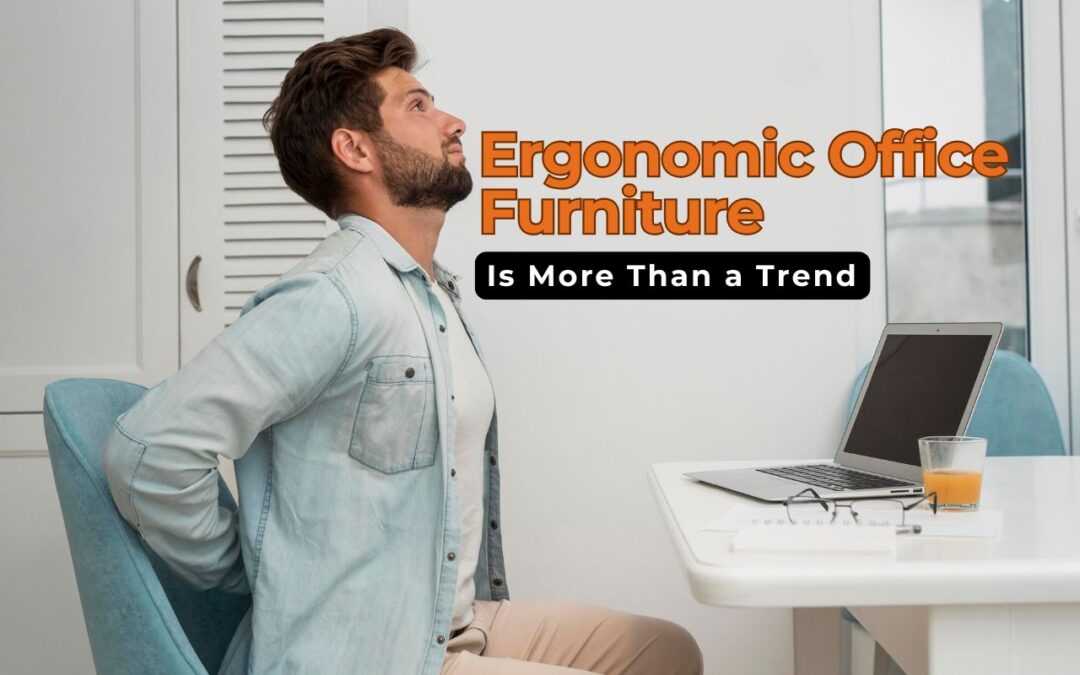In today’s dynamic work environment, conversations around health, productivity, and workplace satisfaction are increasingly drawing attention to one seemingly simple factor—furniture. But not just any kind of furniture—ergonomic office furniture. While some initially dismissed it as just another corporate trend, ergonomic furniture has proven itself to be much more than a fleeting office fad. It has become a central element in designing workspaces that truly support the people who use them.
With the rise of hybrid work, longer desk hours, and a growing emphasis on employee wellness, ergonomic furniture is now synonymous with modern workplace design. But why is it gaining such traction? And more importantly, why is it here to stay?
This blog explores the deeper impact of ergonomic office furniture—how it transforms health, productivity, and even company culture—while also shedding light on why adopting it is not a luxury but a necessity in the future of work.
Understanding Ergonomics: Beyond Comfort
At its core, ergonomics is the science of designing tools, equipment, and workspaces that fit the human body’s natural movements and limitations. When applied to furniture, it focuses on providing support to muscles, joints, and the spine, ensuring that prolonged periods of sitting or working do not strain the body unnecessarily.
Traditional office furniture is often standardized, made with aesthetics and cost in mind rather than individual needs. This one-size-fits-all approach often results in discomfort, repetitive strain injuries, and poor posture. On the other hand, ergonomic furniture is engineered with adjustability and flexibility, allowing users to customize their seating and desk positions based on their unique physical requirements.
The Rise in Sedentary Lifestyles: A Health Crisis in the Making
Let’s face it: modern jobs, especially in tech and administration, require a significant amount of screen time. Many professionals spend upward of eight hours a day sitting in front of a computer. Over time, this sedentary lifestyle takes a heavy toll—leading to back pain, neck stiffness, eye strain, and more serious conditions like poor circulation, muscular degeneration, and chronic fatigue.
Ergonomic office furniture serves as a preventative measure. By promoting better posture, spinal alignment, and movement throughout the day, it actively reduces the physical risks associated with prolonged sitting. It helps the body stay aligned and supported, lowering the chances of developing long-term health issues.
Productivity and Performance: The Hidden Link
The impact of ergonomic furniture on employee productivity is often underestimated. Consider this: when someone is physically uncomfortable, it becomes difficult to concentrate. Minor irritations like a stiff neck, an aching lower back, or numb legs can become major distractions.
Ergonomic workstations are built to minimize such discomfort. When employees are properly supported, they not only experience fewer aches and pains, but they also report higher levels of concentration, faster task completion, and improved mental alertness. By removing physical distractions, these setups enable employees to focus on the work at hand without being slowed down by discomfort.
Furthermore, many people report feeling more motivated when their workspaces are designed with their comfort and well-being in mind. This emotional uplift can translate into a more positive work environment and better team morale.
A Psychological Shift: Empowering Workers
There’s a psychological aspect to ergonomic furniture that goes beyond physical health. When companies invest in the well-being of their employees through ergonomically designed environments, it sends a strong message: “We care about you.” This builds trust, loyalty, and a sense of value among team members.
In fact, many organizations that adopt ergonomic furniture notice a shift in company culture. Employees feel more empowered, respected, and valued. When individuals are given control over how they work—whether that’s adjusting a chair, shifting desk heights, or moving between sitting and standing—they tend to take more ownership of their tasks and demonstrate higher levels of engagement.
The Financial Case: Prevention Is Better Than a Cure
Some business leaders hesitate to make the initial investment in ergonomic furniture, believing it to be an unnecessary cost. However, when viewed from a long-term perspective, it’s an investment in employee health, retention, and performance.
Work-related musculoskeletal disorders are one of the leading causes of employee absenteeism. When workers take sick leave due to back pain, carpal tunnel syndrome, or other posture-related issues, the organization incurs not only lost productivity but also potential medical expenses and replacement costs.
Ergonomic furniture reduces these risks substantially. With fewer injuries and health-related complaints, companies see a drop in sick days and a noticeable improvement in overall productivity. In the long run, the cost of outfitting an office with ergonomic solutions is often much less than the costs associated with employee turnover and healthcare claims.
Ergonomics and Remote Work: A Growing Necessity
The global shift toward remote and hybrid work has brought home office setups into focus. Many professionals working from home initially settled for kitchen chairs and makeshift desks, leading to a surge in physical complaints.
As remote work continues to be a major part of professional life, the need for ergonomic setups outside traditional offices has become just as important. Employees are now looking to their employers for support in creating home workspaces that are comfortable and sustainable.
Companies that provide guidance—or even stipends—for ergonomic furniture in home settings are finding it easier to retain talent and keep productivity high, regardless of physical location.
Sustainability and Ergonomics: A Conscious Connection
Interestingly, many ergonomic furniture options also align with the broader push for sustainability in the workplace. Because they are designed for long-term use and durability, these pieces often have a longer life span compared to cheaper alternatives that wear down quickly and end up in landfills.
Furthermore, by reducing the frequency of employee injuries and the need for short-term fixes or replacements, ergonomic furniture helps companies minimize waste and manage resources more responsibly. A well-designed ergonomic chair or desk, built to last and serve health needs, represents a more conscious and thoughtful way of equipping a modern office.
Training and Awareness: Making Ergonomics Work
Simply purchasing ergonomic furniture is not enough. Without proper education and training, users may not utilize the features effectively. For example, an adjustable chair or desk can only benefit the user if they know how to set it at the correct height or angle for their body type.
Workplace wellness programs that incorporate ergonomic training—such as posture assessments, stretching exercises, and tips for desk setup—can enhance the benefits of ergonomic furniture significantly. When employees understand how to use their tools correctly, they are more likely to experience the full range of health and productivity benefits.
Future of Work: Ergonomics as a Design Principle
As the workplace continues to evolve, one thing is becoming increasingly clear: comfort, health, and flexibility are no longer perks—they’re expectations. Ergonomic design is no longer just a niche or luxury concept; it’s foundational to the way we build environments for work.
Modern office design is shifting toward adaptable, wellness-oriented spaces that can evolve with changing needs. Ergonomic furniture is central to this shift. It promotes movement, supports physical health, and adapts to diverse users. It also aligns with larger trends in workplace innovation, including biophilic design, collaborative layouts, and technology-enabled workstations.
Ergonomics is not going away. On the contrary, as our understanding of human-centered design deepens, it will continue to influence how we build and experience work environments.
Real Impact, Real Results: Why It’s Not Just a Trend
The popularity of ergonomic office furniture may have started with a trend, but its staying power lies in its ability to deliver measurable, lasting benefits. Companies that invest in ergonomic solutions consistently report:
- Reduced employee injuries
- Improved posture and physical comfort
- Increased focus and mental clarity
- Better employee retention and satisfaction
- Enhanced company culture
- Reduced healthcare and absenteeism costs
These outcomes are not theoretical—they’re being experienced across industries, roles, and work styles. In a competitive market, where talent is hard to retain and productivity is constantly under scrutiny, creating a supportive work environment through ergonomic design is simply smart business.
Conclusion: Ergonomics Is the Future of Work Design
Ergonomic office furniture is more than just an office upgrade. It’s a strategic decision—a blend of science, empathy, and foresight that enhances both human well-being and business performance. It acknowledges the complexity of modern work and offers a practical solution to one of its most pressing challenges: how to support people in doing their best work, comfortably and sustainably.
If you’re still thinking of ergonomic furniture as a passing phase or just an optional workplace perk, it’s time to rethink. As the nature of work continues to evolve, so too must the environments in which it takes place. Ergonomics is no longer just an option. It’s the foundation of a healthier, more human-centered approach to work.
Frequently Asked Questions
1. Why is ergonomic furniture considered important in modern offices?
It supports physical health, reduces strain from prolonged sitting, and enhances productivity by improving comfort and concentration.
2. Is ergonomic furniture only for people with existing health issues?
Not at all. It’s designed to prevent health issues and improve comfort for all users, not just those with injuries or chronic pain.
3. Can small businesses afford to invest in ergonomic furniture?
Yes. While the initial cost might be higher, the long-term savings from reduced absenteeism and increased employee satisfaction make it a smart investment.
4. What are some common features of ergonomic furniture?
Adjustability, lumbar support, movement-friendly design, and customization for individual needs.
5. How can remote workers benefit from ergonomic setups?
Remote workers spend similar hours at desks, so ergonomic furniture helps them stay healthy, focused, and comfortable, just like in a traditional office.













